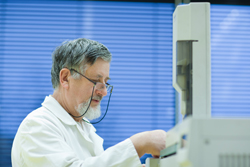Nano-miniaturisation for gas sensors
The ability to detect trace amounts of toxic or explosive gases in the air is of vital importance, not only to workplace safety but to homeland security in the face of possible terrorist actions. Metal oxide (MOX) semiconductor gas sensors have received widespread attention due to their stability and sensitivity. They work via a gas-sensitive MOX film whose electrical properties change in the presence of certain molecules. When the sensing is accomplished by nano-structured materials such as semiconductor MOX-based nanowires (NWs), tremendous decreases in size and power consumption can be achieved. Scientists initiated the EU-funded project S3 to develop a new generation of cost-effective MOX gas nanosensors. These will be used for detecting toxic and explosive gases with superior selectivity, sensitivity and stability (the three S's) combined with miniaturisation and power autonomy. Investigators are targeting nitrogen dioxide (NO2) and trinitrotoluene (TNT) for explosives applications, and ammonia (NH3) and hydrogen sulphide (H2S) for toxicity monitoring in the environment and workplace. Innovative design is enabling the acquisition of multiple signals consisting of resistive response (RES), surface ionisation (SI) and catalytic heat conductivity (CH) from a single sensing layer. To reduce size and heating power consumption, scientists are studying thin ceramic film heater substrates, the use of single NW gas sensors for microwatt power consumption and a new type of microelectromechanical system (MEMS) based on thin alumina film (TAF). Novel nano-sensing materials and systems developed for the project are exhibiting clear RES and SI responses. The development of nanometrology tools and theoretical simulations are helping to screen materials and optimise sensing behaviour. Scientists have also built a unit for vaporisation of targets not in gaseous form, such as explosive particle residue and illegal drugs. S3 is developing multifunctional chemical sensors to detect toxic, explosive or illicit substances. Miniaturised devices based on novel nano-scale structures are facilitating a significant decrease in power consumption, to date the limiting factor to autonomous sensor networks functioning over extended time frames. Devices with decreased size and power consumption together with increased selectivity, sensitivity and stability will no doubt quickly find a niche in the global sensing market.







